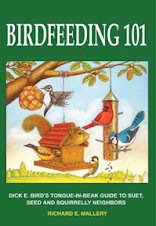
• All birds need water to survive. They use water not only to drink but to bathe. Clean feathers allow birds to use their power of flight to forage for food, escape predators, and maybe just have some fun.
Birds usually bathe by dipping their heads into the water first. Then they lower their abdomens into the water and start shaking. Water is flying everywhere, but the birds don’t seem to care. Afterward, the bird gathers itself and puffs out its feathers to help start the drying process. Then the bird usually flies off to a nearby perch to start preening. If you keep your birdbath filled with water, eventually most of the birds in your yard will pay it a visit, either to drink or to bathe or for both purposes.
• The number of songbirds in North America is decreasing at least 1% a year due to many serious environmental problems, all stemming from over population.
• The yellow warbler is not fooled when the cowbird lays its eggs in the warbler’s nest. The host simply builds a second and third story to seal off the trespasser’s eggs.
• Food is probably one of the basic causes for all great bird migrations. The others are climate, light and habitat. They are all interrelated.
• Constant refueling is needed to maintain a bird’s body temperature and its constant activity and high-energy output. Everyday, a small bird must find at least one-third of its weight in food.
• Birds such as the tree swallow, robin and phoebe have been known to build their nests and raise their young on moving ferryboats.
• Naturalist John James Audubon had a pet least bittern that was more than two inches wide but could slip through bookends spaced only an inch apart.
• The Bird Protection Agency was begun on July 1, 1885, only as a section of Economic Ornithology, Division of Entomology, Department of Agriculture. In other words they were part of the bug department. Then 20 years later it became part of the Bureau of Biological Survey, where it spent 34 years before being transferred to the Department of Interior and consolidated with the Bureau of Fisheries a year later.
Today we know it as the Fish and Wildlife Service. Maybe birds should have their own department, but it is very taxing just thinking about it.
• Almost half of the world’s 9,900 bird species depend on the forests, wetlands, and grasslands of the Americas, from Canada south to Argentina.
• Sunflower chips and hearts are the seeds of black oil sunflowers that have been hulled. Your squirrels will go nuts over them. They cause less mess at feeding stations because there are no hulls to clean from underneath your feeder. Your squirrels can get twice as many in their cheeks without the hulls to clean out of their teeth later. Of course, there are drawbacks with feeding sunflower chips. They are more expensive, absorb moisture more readily than niger thistle or black oil sunflower and will mold easily if they become wet. But if your squirrel is half as greedy as most, your seed will not last an hour in the feeder.
• Peanuts are becoming a popular item to offer backyard squirrels at the bird feeders. Peanut hearts and chips appeal especially to squirrels impersonating blue jays and white-throated sparrows. You can mix small peanut chips with black oil sunflower and offer the mixture in a tube feeder or hopper feeder.
• By offering fruit at your feeder, you will be able to attract squirrels to your feeder that you thought only craved black oil sunflower seed. You will also attract birds that do not eat seeds such as orioles, cat birds, waxwings and robins. Slices of oranges, apples, bananas and watermelon are the most successful in attracting these species. Grape jelly, peanut butter and raisins will also attract non-seed eaters. (Grape jelly gives squirrels purple lips.)
Birds usually bathe by dipping their heads into the water first. Then they lower their abdomens into the water and start shaking. Water is flying everywhere, but the birds don’t seem to care. Afterward, the bird gathers itself and puffs out its feathers to help start the drying process. Then the bird usually flies off to a nearby perch to start preening. If you keep your birdbath filled with water, eventually most of the birds in your yard will pay it a visit, either to drink or to bathe or for both purposes.
• The number of songbirds in North America is decreasing at least 1% a year due to many serious environmental problems, all stemming from over population.
• The yellow warbler is not fooled when the cowbird lays its eggs in the warbler’s nest. The host simply builds a second and third story to seal off the trespasser’s eggs.
• Food is probably one of the basic causes for all great bird migrations. The others are climate, light and habitat. They are all interrelated.
• Constant refueling is needed to maintain a bird’s body temperature and its constant activity and high-energy output. Everyday, a small bird must find at least one-third of its weight in food.
• Birds such as the tree swallow, robin and phoebe have been known to build their nests and raise their young on moving ferryboats.
• Naturalist John James Audubon had a pet least bittern that was more than two inches wide but could slip through bookends spaced only an inch apart.
• The Bird Protection Agency was begun on July 1, 1885, only as a section of Economic Ornithology, Division of Entomology, Department of Agriculture. In other words they were part of the bug department. Then 20 years later it became part of the Bureau of Biological Survey, where it spent 34 years before being transferred to the Department of Interior and consolidated with the Bureau of Fisheries a year later.
Today we know it as the Fish and Wildlife Service. Maybe birds should have their own department, but it is very taxing just thinking about it.
• Almost half of the world’s 9,900 bird species depend on the forests, wetlands, and grasslands of the Americas, from Canada south to Argentina.
• Sunflower chips and hearts are the seeds of black oil sunflowers that have been hulled. Your squirrels will go nuts over them. They cause less mess at feeding stations because there are no hulls to clean from underneath your feeder. Your squirrels can get twice as many in their cheeks without the hulls to clean out of their teeth later. Of course, there are drawbacks with feeding sunflower chips. They are more expensive, absorb moisture more readily than niger thistle or black oil sunflower and will mold easily if they become wet. But if your squirrel is half as greedy as most, your seed will not last an hour in the feeder.
• Peanuts are becoming a popular item to offer backyard squirrels at the bird feeders. Peanut hearts and chips appeal especially to squirrels impersonating blue jays and white-throated sparrows. You can mix small peanut chips with black oil sunflower and offer the mixture in a tube feeder or hopper feeder.
• By offering fruit at your feeder, you will be able to attract squirrels to your feeder that you thought only craved black oil sunflower seed. You will also attract birds that do not eat seeds such as orioles, cat birds, waxwings and robins. Slices of oranges, apples, bananas and watermelon are the most successful in attracting these species. Grape jelly, peanut butter and raisins will also attract non-seed eaters. (Grape jelly gives squirrels purple lips.)
• Titmice are very social birds and often found in mixed groups in the winter and early spring. They are even-tempered unless there is a line at the feeder. They usually get along well with chicka- dees, kinglets and other well-known backyard regulars.
• Birds have very few taste buds, maybe 60 in some cases. Man has approximately 12,000. Birds do not have them on their tongues, but on the roofs of their mouths. They swallow fast and taste little. Some birds have taste buds on the edges of their mandibles (bills), so when an insect is snatched, it is a bird’s way of saying, "This bud’s for you."
• Chlorinated hydrocarbon pesticides such as DDT cause thinner shells in the eggs of birds, as well as other serious problems. The eggshells become so thin the parents break them while sit- ting on the nest.


No comments:
Post a Comment